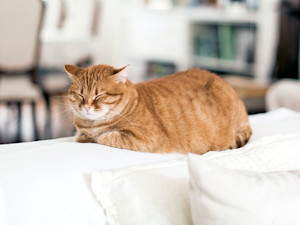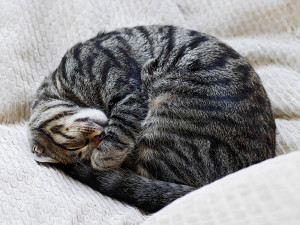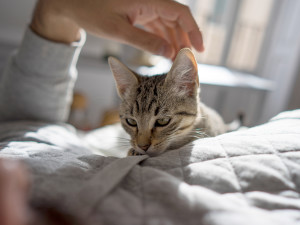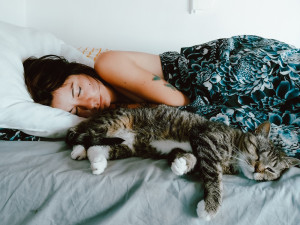Why Do Cats Tuck Their Paws? The Cat Loaf Explained
It’s not just cute—it can be a sign of something more.

Share Article
In This Article:
Do All Cats Tuck Their Paws? What Does Paw Tucking Look Like? 5 Common Reasons Why Cats Tuck Their Paws It’s Not Just Cats: Similar Behaviors in Other Animals Bottom Line: Why Cats Tuck Their Paws Frequently Asked Questions
Have you ever walked into a room to find your cat sitting in a picture-perfect “loaf” position — paws tucked neatly underneath, body compact like a warm, fuzzy bread roll? Your kitty friend is loafing. Despite how typical this behavior is, many pet parents are baffled by it. Is your cat relaxed? Are they cold? Are they scheming or plotting something mischievous?
Keep reading to unwrap the mystery of the paw tuck and find out why cats choose to loaf.
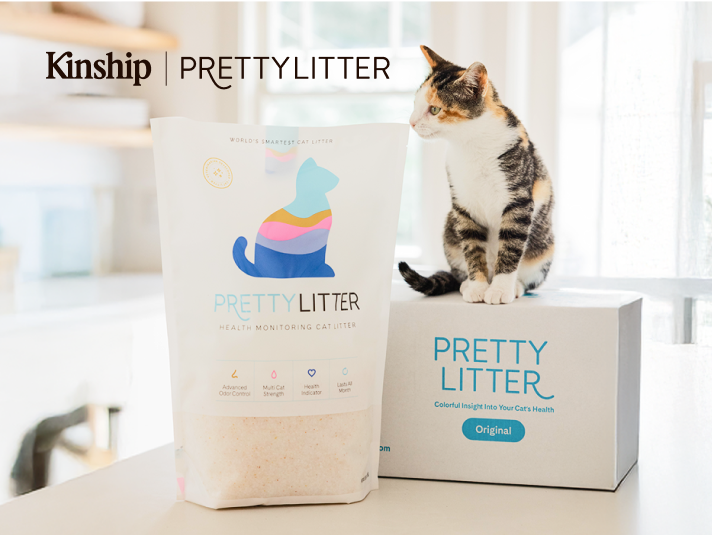
Save on the litter with color-changing tech that helps you better care for your cat.
Do all cats tuck their paws?
While most cats tuck their paws occasionally, not every cat is a serial loafer. Some may prefer the full sprawl (legs out, belly up, zero modesty), while others may be too twitchy, energetic, or grumpy to relax into a loaf position.
How much do you spend on your pet per year?

Paw tucking is natural and instinctive for many cats. Kittens, adult cats, and even big felines in the wild have been observed sitting in variations of this pose. It’s part of feline body language — subtle, often misunderstood, and loaded with meaning depending on the context.
If your cat doesn’t loaf often, don’t panic. They’re probably expressing their personality from a different position.
What does paw-tucking look like?
A proper cat loaf is hard to miss once you know what to look for.
Front paws tucked entirely under the chest
Back legs folded close to the body
Tail wrapped neatly around or tucked underneath
No limbs visible
Some cats opt for a partial loaf, when one paw sticks out lazily. Others master the tight loaf, when everything is tucked precisely, resembling a perfect dinner roll. Whatever the form, the intention remains: comfort, calm, and a touch of compact-stealth mode.
Five common reasons why cats tuck their paws
Relaxation
The most common reason your cat tucks their paws is to be more comfortable and relaxed This is a sign they feel safe in their environment and surroundings. When a cat is loafing, they’re at ease but not entirely asleep; it’s more like they’re resting in standby mode.
Regulating body temperature
Cats don’t just loaf to be adorable; they’re conserving warmth. Tucking in their paws and curling their body reduces exposed surface area, helping them retain heat. You may notice more loafing and tucked paws during colder months or near drafty windows.
Reducing vulnerabilities
Loafing can be a strategic move. Cats reduce injury risks in uncertain environments when they tuck their limbs in and cover their vulnerable belly. Even domesticated house cats are hard-wired to remain semi-defensive.
On alert
Cats with tucked paws aren’t always wholly relaxed. They’re resting, keeping one eye (and ear) on the world around them. They may not be ready to pounce but are still attentive and aware.
Hiding an illness
While the loaf is usually innocent and adorable, there are times when mean they are using self-soothing behaviors because they aren’t comfortable. A cat who loafs frequently but seems tense or won’t let you near their paws may be in pain. This is especially true if they tuck tightly for long periods and avoid movement.
Call your vet if the loaf looks strained with hunched shoulders, sunken eyes, or labored breathing. The loaf could be a disguise for something more serious.
It’s not just cats: similar behaviors in other animals
Cats aren’t the only animals that tuck their paws and loaf in the animal kingdom. Rabbits often tuck their legs under their bodies to relax and feel secure. Birds, too, will sit on both feet with feathers fluffed when resting or trying to stay warm.
Even dogs sometimes do a modified version of loafing, though with less grace and more drool. These animal behaviors all serve a common purpose: comfort, protection, and energy conservation.
Bottom line
Loafing cats are sending you clues about how they feel. Whether it’s a sign of trust, a cozy attempt at staying warm, or a subtle way to reduce exposure in unfamiliar territory, tucked paws and a perfect loaf position are iconic pieces of feline body language. According to Dr. Leslie Sinn, a veterinary behaviorist in Ashburn, Virginia, a proper bread-loaf position is relaxed without tenseness or rigidity.
As a pet parent, your job is to observe the context. Is your cat tucking their paws and relaxing in a sunbeam? Are they loafing and hiding under the bed for hours, avoiding contact? The loaf is a language all its own.
FAQs
What is a cat loaf?
A “cat loaf” refers to a position where a cat tucks their paws and limbs underneath their body, resembling a fluffy loaf of bread.
Why do cats lie with their paws tucked?
Cats tuck their paws when relaxed, staying warm, or protecting vulnerable limbs while resting.
What is it called when cats tuck their paws?
This cozy pose is affectionately called “loafing.” It’s a typical feline resting position.
What does it mean when a cat sits like a loaf?
It usually means your cat feels calm and secure, although they’re still alert and ready to respond if needed.
What does it mean when cats curl their paws?
Curled paws often indicate relaxation and comfort, though in some cases, they can signal joint pain or discomfort. Context is key.
References
American Pet Products Association. “Pet Industry Market Size & Ownership Statistics.” APPA, 2023. https://www.americanpetproducts.org/press_industrytrends.aspopens in new tab
"Cat Loaf Pose: What Is It & Why Do Cats Loaf?" Purina, 13 Dec. 2024, www.purina.com/articles/cat/behavior/understanding-cats/why-do-cats-loafopens in new tab
Ollila, Erin. "The Cat Loaf: What Is It & Why Do Cats Loaf, Anyway?" Hill's Pet Nutrition, 19 July 2021, www.hillspet.com/cat-care/behavior-appearance/what-is-a-cat-loafopens in new tab
Sinn, Leslie. "About Dr. Sinn." Behavior Solutions, www.behaviorsolutions.guru/about-dr-sinnopens in new tab

Valerie Mellema
Valerie Mellema has a Bachelor of Science in Agribusiness and Equine Industry from West Texas A&M University. She has been a professional writer for the past 20 years, covering a wide variety of pet health and care topics before founding a nonprofit focused on mental health in children and thoroughbred aftercare. She has four Border Collies and eight retired racehorses.
Related articles
![kitten sleeping on top of person]()
Why Does Your Cat Sleep on You? 7 Reasons and What It Means
Not into cuddling? Too bad—they’re spending the night.
Why Does My Cat Sleep Between My Legs?
Here are the most common reasons.
![woman with dark hair lying in bed with striped cat, both asleep]()
Should I Let My Cat Sleep With Me? Things to Consider About Having Your Cat in Bed
Here are the pros and cons of having a feline sleeping buddy.
![a red cat stretching on a bed]()
Why Is My Cat Twitching in Their Sleep?
Sure, it’s curious—but is it also concerning?
Why Does My Cat Sleep at My Feet?
Other than the fact that they love you so very much.
Why Does My Cat Watch Me Sleep?
Is it creepy or sweet? With help from an expert, we got to the bottom of why they’re staring at you.
![Cat sleeping on the sofa at home.]()
The Cat “Loaf” Position Is Super Cute—But Why Do They Do It?
Besides looking like the perfect little sourdough baby.
